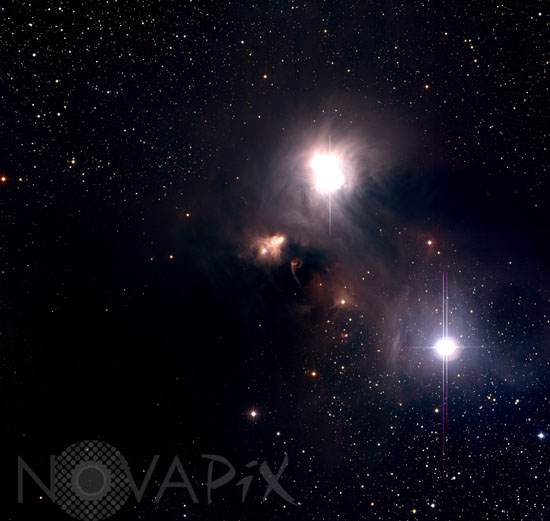Photo Agency - Astronomy - Space - Nature

The Corona Australis nebula (NGC 6726-27-29)
author: ESO/Novapix
reference: a-neb67-26001
Image Size 300 DPI: 25 * 24 cm
Image of R Coronae Australis region in the southern Milky Way, obtained with the Wide Field Imager (WFI) (camera) at the 2.2-m MPG/ESO Telescope on La Silla (Chile). The R Coronae Australis complex of young stars and interstellar gas clouds is one of the nearest star-forming regions, at a distance of approx. 500 light-years from the Sun. It is seen in the southern constellation of that name (The "Southern Crown"). R Coronae Australis, the bright star from which the entire complex is named, is located at the center of the field and illuminates the reddish nebula around it. The bright star in the lower part, illuminating a somewhat bluer nebula, is known as TY Coronae Australis. The brightness of these two stars and several others in the same field is variable. They belong to the so-called "T Tauri" class, a type that is quite common in star-forming regions. T Tauri stars are in the early stages of stellar evolution and display various observable characteristics of this phase, e.g. emission at visible and infrared wavelengths due to the accretion of matter left over from their formation, as well as X-ray emission. The nebulosity seen in this picture is mostly due to reflection of the stellar light by small dust particles. The stars in the R Coronae Australis complex do not emit sufficient ultraviolet light to ionize a substantial fraction of the surrounding hydrogen, and thereby cause this gas to glow. Also visible are so-called Herbig-Haro objects, dense clumps of gas ejected from the immediate vicinity of newly formed stars with velocities of about 200 km/sec. When such clumps ram into the gas, the atoms are heated (excited) and start to shine. The observations were obtained on the night of 30 August 2000.
Contact : Stéphane Aubin +33-(0)9-51-26-53-76
© Novapix - All rights reserved


